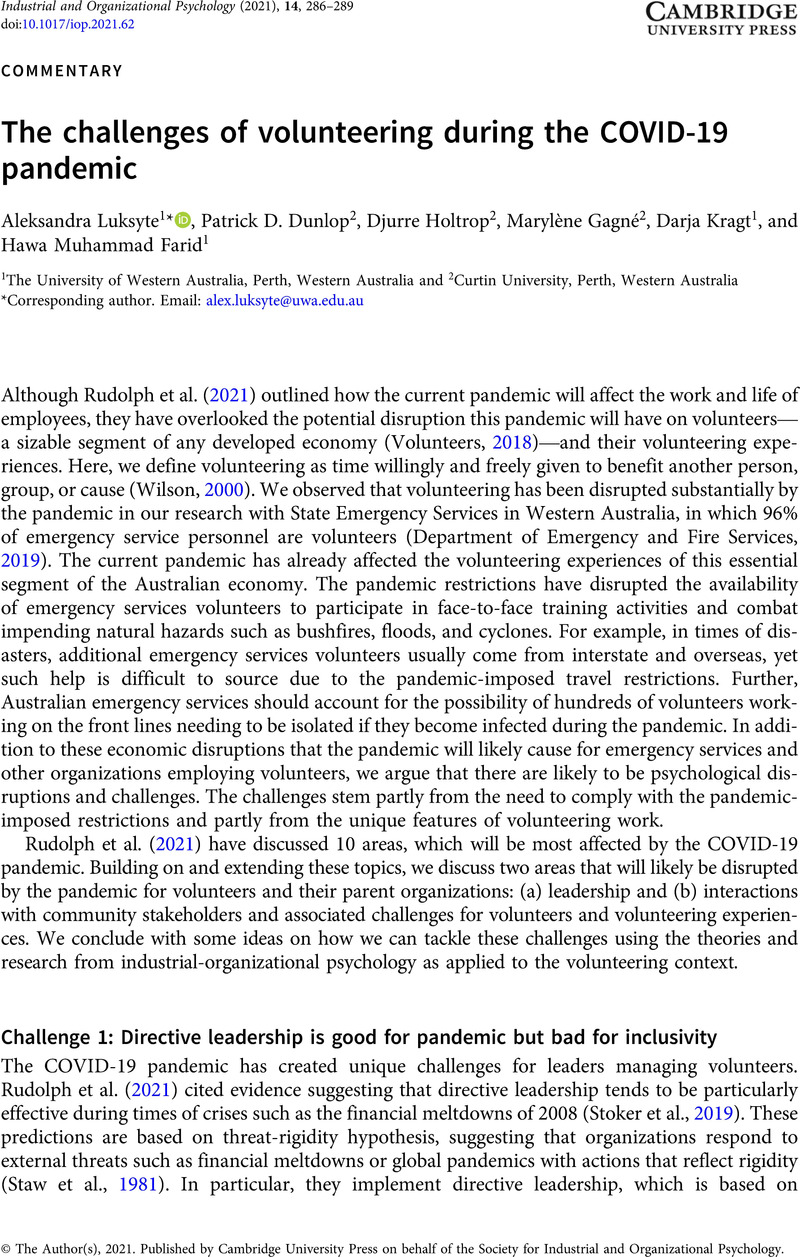Crossref Citations
This article has been cited by the following publications. This list is generated based on data provided by Crossref.
Dunlop, Patrick D.
Holtrop, Djurre
Kragt, Darja
Gagné, Marylène
Muhammad Farid, Hawa
and
Luksyte, Aleksandra
2022.
Setting expectations during volunteer recruitment and the first day experience: a preregistered experimental test of the met expectations hypothesis.
European Journal of Work and Organizational Psychology,
Vol. 31,
Issue. 6,
p.
842.
Mouloudj, Kamel
and
Bouarar, Ahmed Chemseddine
2023.
Investigating predictors of medical students' intentions to engagement in volunteering during the health crisis.
African Journal of Economic and Management Studies,
Vol. 14,
Issue. 2,
p.
205.
Jarvis, Mary Ann
Pillay, Suntosh R.
Norton, Lynn M.
Hiraman, Nemisha
and
Baloyi, Olivia B.
2023.
Delivering a psychosocial program for older people living in retirement homes during the Covid‐19 pandemic: A process evaluation and recommendations for community interventions.
Journal of Community Psychology,
Vol. 51,
Issue. 1,
p.
31.
Sun, Peter C.
Morrow-Howell, Nancy
and
Pawloski, Elizabeth
2023.
Pandemic Pivots for Older Volunteers: Online Tutoring and Pen Pal Programs.
Journal of Gerontological Social Work,
Vol. 66,
Issue. 4,
p.
548.
Rizzo, Amelia
Yıldırım, Murat
Aziz, Izaddin Ahmad
Çağış, Zafer Güney
Szarpak, Łukasz
Nucera, Gabriella
Sitibondo, Aldo
Khabbache, Hicham
Chirico, Francesco
and
Nowrouzi-Kia, Behdin
2023.
Anxiety and Coping Strategies among Italian-Speaking Physicians: A Comparative Analysis of the Contractually Obligated and Voluntary Care of COVID-19 Patients.
Healthcare,
Vol. 11,
Issue. 23,
p.
3044.
Gray, Debra
Randell, Jordan
Manning, Rachel
and
Cleveland, Michelle
2024.
Helping in times of crisis: Examining the social identity and wellbeing impacts of volunteering duringCOVID‐19.
Journal of Community & Applied Social Psychology,
Vol. 34,
Issue. 1,
Qu, Guoliang
Ju, Enxia
Qin, Guanglun
Chen, Xuhai
and
Luo, Yangmei
2024.
Profiles of volunteers' motivations and positive experiences relate to their sustained volunteering during the COVID‐19 pandemic.
Journal of Community & Applied Social Psychology,
Vol. 34,
Issue. 1,
Innes, Peter A.
Jefferies, Gerard
and
Gates, Trevor G.
2024.
Volunteering behavioral declines amid personal and organizational upheaval: Recruitment, retention, and barriers in Australia.
Journal of Human Behavior in the Social Environment,
p.
1.
Holtrop, Djurre
Soo, Christine
Gagné, Marylène
Kragt, Darja
Dunlop, Patrick D.
and
Luksyte, Aleksandra
2024.
Exploring Volunteer Turnover Reasons, Intentions, and Behavior.
Group & Organization Management,
Forner, Vivien W.
Holtrop, Djurre
Boezeman, Edwin J.
Slemp, Gavin R.
Kotek, Magdalena
Kragt, Darja
Askovic, Mina
and
Johnson, Anya
2024.
Predictors of turnover amongst volunteers: A systematic review and meta‐analysis.
Journal of Organizational Behavior,
Vol. 45,
Issue. 3,
p.
434.
Thomas, Benjamin J.
2024.
Understanding nonprofit leader engagement and turnover: A story of job demands and resources.
Nonprofit Management and Leadership,
Vol. 34,
Issue. 3,
p.
707.
Alizadeh, Hooshmand
Doostvandi, Milad
and
Zandsalimi, Milad
2024.
Redefining sustainable urban development: A critical analysis in the wake of COVID‐19.
Sustainable Development,
Vol. 32,
Issue. 6,
p.
6163.
Son, Joonmo
Sung, Pildoo
and
Tay, Benjamin
2025.
Well-being During the Pandemic.
Vol. 90,
Issue. ,
p.
193.
Son, Joonmo
Mesa, Leika
Wong, Yu Ping
and
Stanford, Mark
2025.
The Latent Classes of the Volunteer Satisfaction Index and Volunteering during the Pandemic in Singapore.
Social Indicators Research,
Kelle, Nadiya
Bünning, Mareike
and
Simonson, Julia
2025.
COVID-19 Pandemic, Volunteering, and Well-Being: Volunteering’s Role in Mitigating Depressive Symptoms, Loneliness, and Perceived Social Exclusion during the Pandemic.
Social Indicators Research,
Shaw, Duncan
Zanjirani Farahani, Reza
and
Scully, Judy
2025.
Sustaining spontaneous volunteer groups following their response to a disaster.
International Journal of Operations & Production Management,
Vol. 45,
Issue. 1,
p.
246.
Shen, Hongzhou
Chen, Qirui
and
Li, Changcheng
2025.
Online profiling of volunteers in public health emergencies: insights from COVID-19 in China.
BMC Public Health,
Vol. 25,
Issue. 1,



